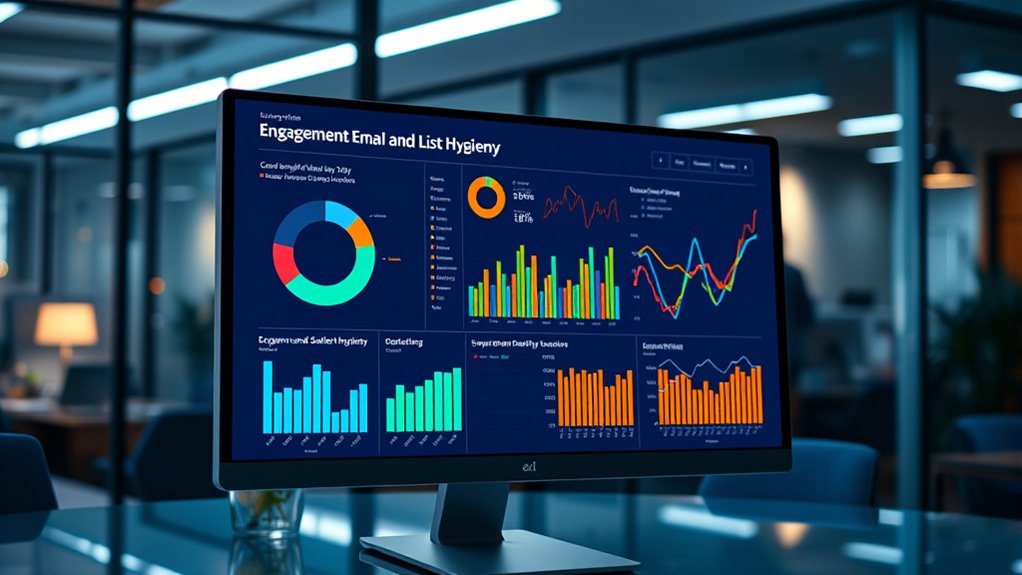To guarantee your emails reach inboxes effectively, demand five key dashboards: Inbox Placement Rate to monitor delivery success; Spam Complaint Monitoring to protect your reputation; Sender Reputation Metrics to track authentication and scores; Bounce and Delivery Failure to analyze email failures; and Engagement and List Hygiene to maintain an active, responsive list. Having these dashboards helps identify issues early, optimize campaigns, and improve overall deliverability. Discover more ways to refine your email strategy and boost results as you explore further.
Key Takeaways
- Inbox Placement Rate Dashboard to monitor email delivery success and optimize formatting for better inbox reach.
- Spam Complaint Monitoring Dashboard to track complaint rates and prevent reputation damage.
- Sender Reputation Metrics Dashboard to assess authentication status and maintain high sender scores.
- Bounce and Delivery Failure Dashboard to analyze bounce reasons and refine email list quality.
- Engagement and List Hygiene Dashboard to oversee subscriber activity, unsubscribe rates, and list health.
Inbox Placement Rate Dashboard

Have you ever wondered how effectively your emails reach your recipients’ inboxes? The Inbox Placement Rate Dashboard helps you answer that. It shows whether your emails land in inboxes or get filtered into spam. To improve this rate, focus on email formatting—using clear, professional layouts that are mobile-friendly. Personalization tactics also play a vital role; tailored content increases engagement and reduces spam complaints. The dashboard provides insights into your campaign performance, highlighting issues like low open rates or high bounce rates. By analyzing this data, you can adjust your email formatting and personalization strategies to optimize inbox placement. Regularly monitoring these metrics guarantees your messages get seen, boosting your overall deliverability and campaign success. Additionally, understanding email content quality ensures your messages align with best practices for higher inbox placement rates.
Spam Complaint Monitoring Dashboard

Building on your efforts to optimize inbox placement, monitoring spam complaints is key to maintaining a healthy sender reputation. Your Spam Complaint Monitoring Dashboard helps you track complaint rates and identify patterns that may harm deliverability. With this dashboard, you can quickly spot spam trap identification issues that cause spikes in complaints, allowing you to adjust your list hygiene practices. It also provides insights into complaint resolution strategies, showing how effectively you respond to recipients who mark messages as spam. By actively managing these metrics, you prevent reputation damage and reduce the likelihood of being blacklisted. Regularly reviewing your complaint data ensures you stay proactive, addressing issues before they escalate and keeping your email program compliant and trustworthy. Incorporating anime film trends can help you better understand audience preferences and tailor your campaigns accordingly.
Sender Reputation Metrics Dashboard

To maintain a strong sender reputation, you need to actively monitor key reputation metrics that influence inbox placement. The Sender Reputation Metrics Dashboard provides essential insights into how your emails are perceived by ISPs. Focus on email authentication signals like DKIM, SPF, and DMARC, which verify your identity and build trust. These factors directly impact sender scoring, a metric used by inbox providers to evaluate your reputation. A high sender score indicates consistent, trustworthy sending behavior, boosting your chances of reaching inboxes. Regularly reviewing this dashboard helps you identify issues early, such as authentication failures or sudden drops in reputation, enabling prompt corrective actions. Understanding the importance of Gold IRA Rollovers can also help diversify your digital communication strategies and protect your outreach efforts during market fluctuations. By maintaining a healthy sender reputation, you guarantee your emails stay out of spam folders and maximize engagement.
Bounce and Delivery Failure Dashboard

Understanding your bounce and delivery failure rates is essential for maintaining a healthy sender reputation and ensuring your emails reach your audience. The Bounce and Delivery Failure Dashboard provides detailed insights into why emails aren’t getting through. By analyzing bounce codes, you can identify whether failures are temporary or permanent, allowing you to take targeted action. Incorporate email list segmentation to pinpoint issues within specific audience segments, helping you refine your list and reduce bounce rates. This dashboard helps you track patterns over time, revealing common causes of delivery failures and guiding your list cleaning efforts. With clear visuals and actionable data, you’ll better understand your email performance, improve deliverability, and protect your sender reputation. Leveraging automation in business can further streamline your email management processes, making it easier to maintain optimal deliverability standards.
Engagement and List Hygiene Dashboard

Maintaining an engaged and healthy email list requires more than just sending messages; it demands ongoing monitoring of how your audience interacts with your campaigns. The Engagement and List Hygiene Dashboard helps you track key metrics like unsubscribe rates and click through analytics. High unsubscribe rates can signal content irrelevance or list fatigue, prompting you to refine your messaging. Click through analytics reveal which links resonate with your audience, guiding content adjustments. Regularly reviewing these metrics helps you identify inactive subscribers, enabling targeted re-engagement campaigns or list cleaning. Additionally, understanding email deliverability best practices can further improve your sender reputation and inbox placement. By keeping a close eye on engagement signals, you ensure your list remains healthy, engaged, and valuable, ultimately boosting deliverability and campaign success. This dashboard is essential for maintaining a vibrant, responsive email list.
Frequently Asked Questions
How Often Should I Review My Deliverability Dashboards?
You should review your deliverability dashboards at least weekly to stay on top of email engagement and list segmentation. Regular checks help you spot issues early, like declining open rates or spam complaints, so you can act quickly. By keeping a close eye, you guarantee your campaigns remain effective, your list stays healthy, and your deliverability stays strong, ultimately boosting your overall email marketing success.
Can Dashboards Predict Future Deliverability Issues?
Predictive power propels your prospects, as dashboards do more than just display data—they deliver insights. While they can’t perfectly predict future issues, leveraging predictive analytics and sender segmentation helps you spot potential problems early. By analyzing trends and segment behaviors, you can proactively address deliverability dilemmas, minimizing mishaps. So, your dashboards act as strategic sentinels, supporting smarter sending strategies and safeguarding your sender reputation.
What Tools Integrate Best With These Dashboards?
You want to know which tools integrate best with your dashboards. Focus on tools that support email segmentation, allowing you to target specific audiences effectively. Also, choose platforms that facilitate IP warming, helping improve your sender reputation over time. These integrations guarantee your dashboards provide thorough insights, enabling you to optimize campaigns, prevent deliverability issues, and maintain high inbox placement rates.
How Do I Interpret Complex Sender Reputation Metrics?
When interpreting complex sender reputation metrics, focus on your Sender Score and IP Reputation to gauge email trustworthiness. A high Sender Score indicates good standing, while IP Reputation reflects how email providers view your server. If these metrics drop, it signals potential deliverability issues. Regularly monitor these indicators, compare trends over time, and act quickly to resolve issues, ensuring your emails reach inboxes consistently.
Are There Industry Benchmarks for Acceptable Bounce Rates?
When evaluating bounce rates, you should consider industry benchmarks for acceptable levels, which typically range from under 2% to 5%, depending on your sector. Focus on improving email engagement and spam trap management to reduce bounces. Monitoring these metrics helps you identify issues early, refine your list, and maintain a healthy sender reputation. Consistently aiming for lower bounce rates guarantees your email campaigns stay effective and reach your audience.
Conclusion
By keeping an eye on these dashboards, you might just discover that good deliverability isn’t magic—it’s strategy. Think of them as your email GPS, guiding you past spam traps and low engagement. Some say the key to inbox success is luck, but I believe data-driven decisions make all the difference. When you actively monitor and optimize, you’re not just reaching inboxes—you’re building trust and growing your audience effortlessly.









